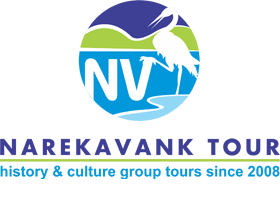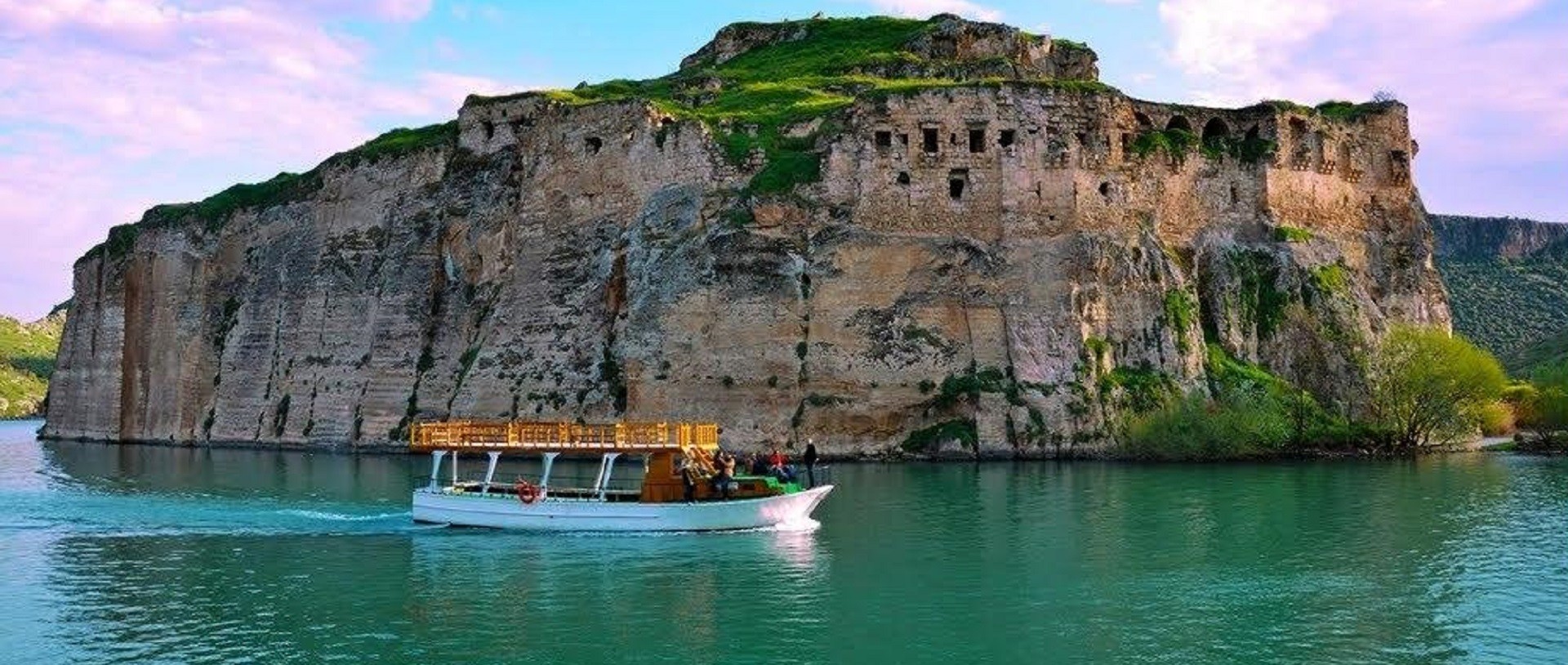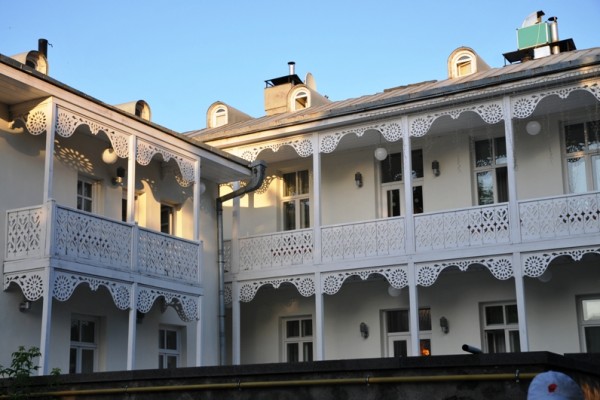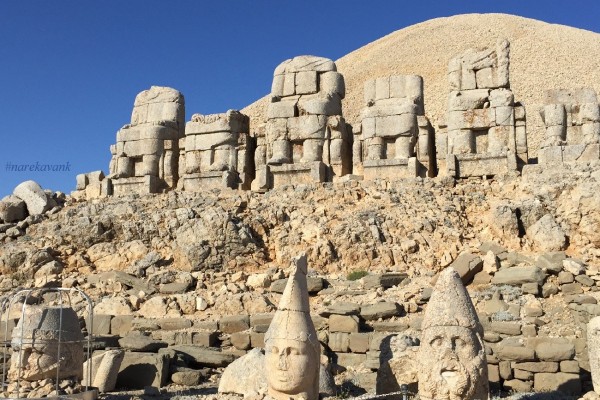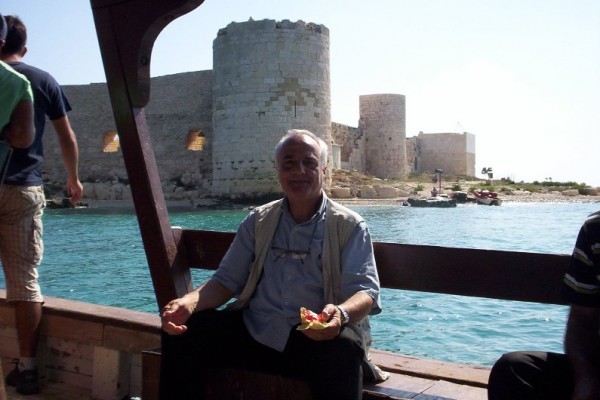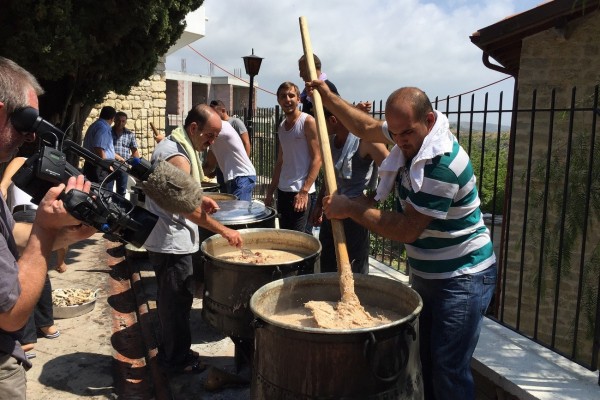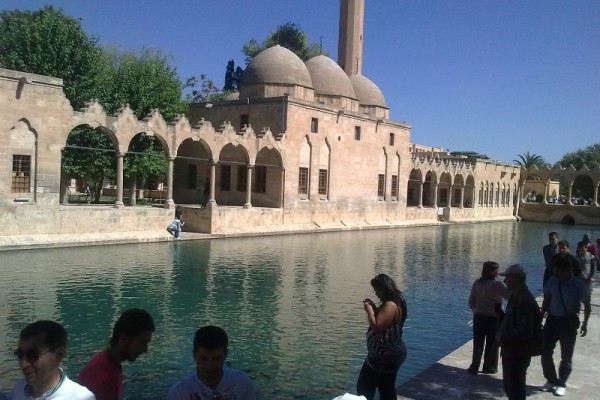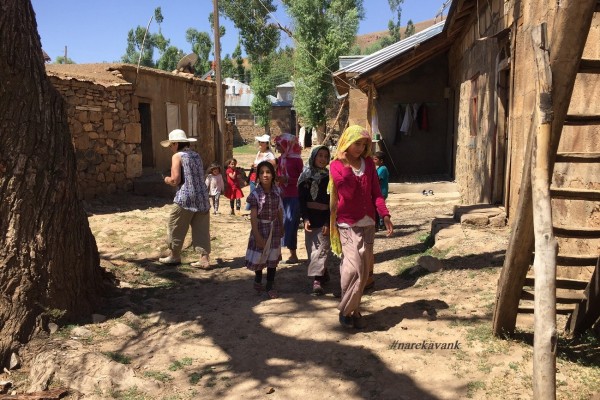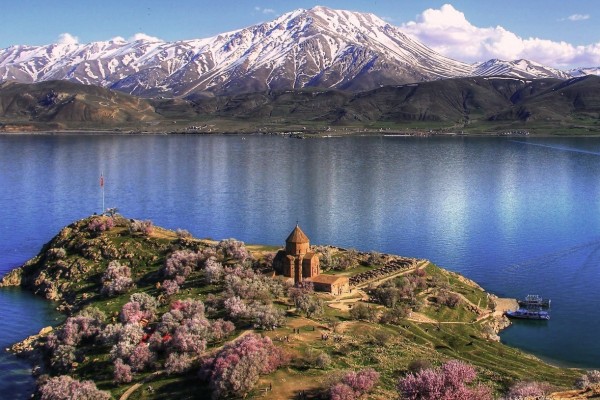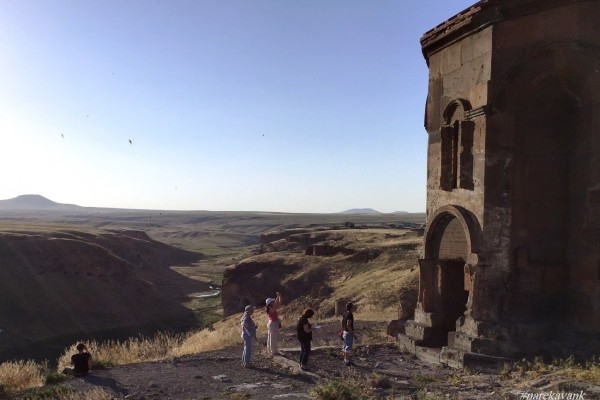Tour Duration
9 days, 8 nights
9 days, 8 nights
Tour Brief
Explore Western Armenia and Cilicia, a marvelous land on the Mediterranean, ✔️ Mount Nemrut by the Euphrates (a UNESCO site), hosting huge statues of Hellenistic gods. Tour the city of ✔️ Urfa – the birthplace of Abraham. Visit the churches of the first Christian communities, the town where Apostle Paul was born, the church, where Apostle Peter preached. Walk through the gate where ✔️ Cleopatra met Mark Antony. Explore ✔️ fortresses of the Crusaders, Urartians and Byzantines that have rock-carved inscriptions of Armenian kings.
Narekavank has been organizing tours to Cilicia since 2008.
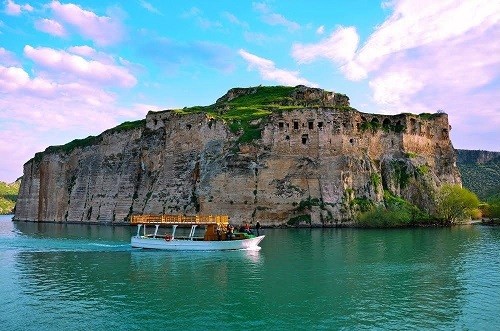
-
Tour cost includes
a) Quality hotel accommodations 3* and 4*,b) Comfortable, air-conditioned vehicles (van, minibus, bus)c) Local tasty meals - half board (breakfast and late lunch),d) Entrance fees to cultural and historical monuments (including ferry boat to Akhtamar Island and Corycus Castle),e) Travel Insurance,f) Professional services of a multi-lingual Tour Guide who accompanies the group. -
Hotels
Erzurum / SarikamisNemrut / Siverek / AdiyamanAdana / Sis / KorikosMusaler / IskenderunMusVanDogubayazit / Muradiye
Tour Program:
▶️ Early in the morning we will depart Yerevan to travel to the Armenian-Georgian border. We will pass through the town of Gyumri, cross the border at Bavra and enter Javakhq, now a part of Samtskhe-Javakheti region of Georgia. We approach the Georgian-Turkish border, enter the Ardahan region and pass by the beautiful Lake Childir or Tsovak.
Arriving in Kars we will tour the city, walk its narrow streets where many 19th-century buildings of Russian and Armenian architecture can still be found. We will see the medieval stone bridge of “Vardan”, the remnants of the house, where Yeghishe Charents, a celebrated Armenian writer lived, and the imposing Church of Apostles (10th century) converted to a mosque. We will ascend to the royal fortress of Kars, once the stronghold of the Armenian capital, the seat of Bagratouni Kings. We then travel to Sarikamis or Erzurum and stay there for the night.
Arriving in Kars we will tour the city, walk its narrow streets where many 19th-century buildings of Russian and Armenian architecture can still be found. We will see the medieval stone bridge of “Vardan”, the remnants of the house, where Yeghishe Charents, a celebrated Armenian writer lived, and the imposing Church of Apostles (10th century) converted to a mosque. We will ascend to the royal fortress of Kars, once the stronghold of the Armenian capital, the seat of Bagratouni Kings. We then travel to Sarikamis or Erzurum and stay there for the night.
- Erzurum City and Byzantine Fortress
- Chifte Minare and Yakutiye Theology Schools
- Sanasarian College
- City of Diyarbakir, St. Kirakos Church
▶️ In the morning we will tour Erzurum (historical Karin), which has been the largest city in Eastern Anatolia, currently known for its strong Turkish nationalism tradition. We will visit the Byzantine Theodoupolis fortress (5th century), the renowned medieval medreses (theology schools) of Chifte Minare and Yakutiye. We will see the 19th-century building of the Sanasarian Armenian College and the Lala Pasha Mosque of a famous Ottoman Architect Sinan (of Armenian origin).
From Erzurum we travel through historical principalities of Highland Armenia and Tsopq, over Bingol/ Byurakn and Palandoken/ Gaylakhazut mountain ranges. We will arrive in Diyarbakir (ancient Amid), the biggest city in the region. Historically it has been a cosmopolitan place where Armenians, Kurds and Assyrians lived. Prior to the 1980s the Armenian community here still existed and had operating churches. Of the latter, we will visit the Church of St. Kirakos (18th century) of a remarkable beauty. We will also see the famous four-foot minaret and impressive black walls of the old city, built in the 4th century by Byzantine Emperor Constantine. Overnight in a town called Siverek not far Diarbekir
OR from here we travel to Euphrates, cross it enjoying the beautiful scenery of the river and the surrounding hills, and continue up toward Mount Nemrut, the highest point of Upper Mesopotamia (2206 m). Overnight accommodations not far from Mount Nemrut.
From Erzurum we travel through historical principalities of Highland Armenia and Tsopq, over Bingol/ Byurakn and Palandoken/ Gaylakhazut mountain ranges. We will arrive in Diyarbakir (ancient Amid), the biggest city in the region. Historically it has been a cosmopolitan place where Armenians, Kurds and Assyrians lived. Prior to the 1980s the Armenian community here still existed and had operating churches. Of the latter, we will visit the Church of St. Kirakos (18th century) of a remarkable beauty. We will also see the famous four-foot minaret and impressive black walls of the old city, built in the 4th century by Byzantine Emperor Constantine. Overnight in a town called Siverek not far Diarbekir
OR from here we travel to Euphrates, cross it enjoying the beautiful scenery of the river and the surrounding hills, and continue up toward Mount Nemrut, the highest point of Upper Mesopotamia (2206 m). Overnight accommodations not far from Mount Nemrut.
- Mount Nemrut, King Antiochus Tomb
- Huge statues of pagan gods
- Fortresses of Anavarza and Levon
- Sis Capital
- Marash or Hromkla
▶️ We will observe the sunrise on the summit of Mount Nemrut – an unforgettable panorama of the western part of the Armenian Plateau, the Taurus Range and the Euphrates. Here lies the tomb of King Antiochus I Theos of Kommagene (a UNESCO World Heritage Site) who called himself a descendant of Alexander the Great and Darius I, whose family roots come from Armenian Yervanduni/ Orontes dynasty. Antiochus was crowned by Tigran the Great, who at that time bore the title of “King of Kings”. We will tour Hellenistic and Armenian pagan pantheon of Zeus-Aramazd, Apollo-Mithras (Tire), Hercules-Vahagn, Fortune (similar to Anahit, the goddess of fertility) - huge, seven-meter tall statues seated on thrones.
Then through the city of Marash or the renowned Hromkla Castle on Euphrates we descend to Cilicia. We will tour the impregnable fortress of Sis (12th century), the heart and the stronghold of the Armenian Kingdom of Cilicia, the city and the citadel of Anazarbus/ Anavarza. Anavarza used to be the capital of both Byzantine and Armenian Cilicia, in the 1st century BC the Roman Emperor Augustus visited this city. We will see the ruins of it and the well-preserved citadel where the inscriptions of Armenian kings still survive. We will also see the castle of King Levon or the Snake Castle (12th century), the primarily stronghold of the Lower Cilicia, located on the Great Silk Road from the Taurus Mountains to Antioch. Overnight in Adana or Sis.
Then through the city of Marash or the renowned Hromkla Castle on Euphrates we descend to Cilicia. We will tour the impregnable fortress of Sis (12th century), the heart and the stronghold of the Armenian Kingdom of Cilicia, the city and the citadel of Anazarbus/ Anavarza. Anavarza used to be the capital of both Byzantine and Armenian Cilicia, in the 1st century BC the Roman Emperor Augustus visited this city. We will see the ruins of it and the well-preserved citadel where the inscriptions of Armenian kings still survive. We will also see the castle of King Levon or the Snake Castle (12th century), the primarily stronghold of the Lower Cilicia, located on the Great Silk Road from the Taurus Mountains to Antioch. Overnight in Adana or Sis.
- Old Adana, Hadrian’s Bridge
- Cilician Capital Tarson, St. Paul Church, Cleopatra Gate
- Sea Fortress of Korikos
- Rest on the Mediterranean Beach
▶️ We will tour old Adana, see the stone bridge of Hadrian (2nd century AD), the old bazaar and the Armenian quarter.
From Adana we travel to Tarson/ Tarsus, the birthplace of Apostle Paul, the capital of Cilicia from the times of the Romans, and later the place where Armenian kings were anointed. Here we will visit the Church of St. Paul and see the gates of Cleopatra, where Cleopatra and Mark Antony met.
Then we head to Kizkalesi resort to visit the famous sea fortress of Korikos (12th century) that rises on an island in the Mediterranean Sea. This fortress, a fiefdom of Oshinyan princes, used to be an important medieval port, a commercial center at the crossroad of Europe and Asia. There is a beautiful beach by Korikos where we will enjoy resting and swimming in the Mediterranean until the evening. Overnight in Korikos.
Then we head to Kizkalesi resort to visit the famous sea fortress of Korikos (12th century) that rises on an island in the Mediterranean Sea. This fortress, a fiefdom of Oshinyan princes, used to be an important medieval port, a commercial center at the crossroad of Europe and Asia. There is a beautiful beach by Korikos where we will enjoy resting and swimming in the Mediterranean until the evening. Overnight in Korikos.
- Passing through Cilicia to Armenian Gulf
- Toward Iskenderun, Belen and Antioch
- Musadagh / Musaler, Armenian Vakif Village
▶️ We travel toward the Armenian (Alexandretta) Gulf, the region of Hatay. We pass Antakya, ancient Antioch, the capital of the Seleucid Kingdom of the 4-2nd centuries BC. From Antakya we take a trip to the only remaining Armenian village in Turkey - Vakif. We will see Musadag (Mount Musa), where locals heroically fought against the Ottoman army and managed to escape during the massacres of Armenians in 1915. In Vakif we will visit the functioning Armenian church, rest in the church yard and meet the locals. Overnight in the hotel not far from the sea.
▶️ Today we will travel to Ayntap (Gaziantep), which was the domain of the Armenian princes of Cilicia in the 12th-14th centuries. The fortress built by the Crusaders (12th century) is still preserved in Antep. In the city we will see St. Elijah's magnificent Armenian cathedral, which has been converted into a mosque.
Then we travel to Urfa (Sanliurfa) or Edessa, located in a historical province that was called Armenian Mesopotamia. It was the place where Mesrop Mashtots invented the Armenian alphabet in 406 AD. The legend has it that Abraham was born in a cave near Urfa. Touring the city we will visit the famous “sacred fish” pool, which, according to the legend, was a huge bonfire, into which the Babylonian King Nimrod threw Abraham. We will see the ancient fortress and converted to mosques Byzantine and Armenian churches. One of the latter allegedly had the kerchief of Christ that cured Armenian King Abgar of Edessa.
From Urfa we travel to Mօush over the mountains of Sasun. Overnight accommodations in Mus.
Then we travel to Urfa (Sanliurfa) or Edessa, located in a historical province that was called Armenian Mesopotamia. It was the place where Mesrop Mashtots invented the Armenian alphabet in 406 AD. The legend has it that Abraham was born in a cave near Urfa. Touring the city we will visit the famous “sacred fish” pool, which, according to the legend, was a huge bonfire, into which the Babylonian King Nimrod threw Abraham. We will see the ancient fortress and converted to mosques Byzantine and Armenian churches. One of the latter allegedly had the kerchief of Christ that cured Armenian King Abgar of Edessa.
From Urfa we travel to Mօush over the mountains of Sasun. Overnight accommodations in Mus.
- Moosh town and valley, Eastern Euphrates, Sulukh Bridge
- Msho “Sultan” Sourb Karapet Cathedral
- Bitlis, Fortress of Alexander Macedonian
- Lake Van
▶️ In Mush we tour the old town and take a trip to the old Murat/ Souloukh bridge on the Euphrates, an important site related to the Armenian national-liberation movement against the Ottoman Empire where one of the leaders, Gevorg Chaush, died. We will then visit the remnants of “Msho Sultan” Sourb Karapet cathedral, once the second important (after Ejmiatsin) religious center of the Armenian Church with wonderful architecture, now all in ruins inside a Kurdish village, the houses of which are built from the fine-cut cathedral stones.
Then we will head to Bitlis (historical Baghesh), which is located in the gorge of the Taurus Mountains. It was the center of the Armenian province of Aghdznik (ruled by bdeshkhs) and later of the Kurdish Emirate (13th-19th centuries). The most impressive sight in Bitlis is its impregnable fortress, the founding of which is attributed to Alexander the Great. From Bitlis we travel to Lake Van. On the way we can stop, relax and enjoy the pleasure of swimming in Lake Van. Overnight accommodations in Van.
Then we will head to Bitlis (historical Baghesh), which is located in the gorge of the Taurus Mountains. It was the center of the Armenian province of Aghdznik (ruled by bdeshkhs) and later of the Kurdish Emirate (13th-19th centuries). The most impressive sight in Bitlis is its impregnable fortress, the founding of which is attributed to Alexander the Great. From Bitlis we travel to Lake Van. On the way we can stop, relax and enjoy the pleasure of swimming in Lake Van. Overnight accommodations in Van.
- Van City and Lake
- Aghtamar Island, Sourb Khach (Holy Cross) Cathedral
- Varagavanq Monastery
- Urartian Tushpa-Van Fortress, Van Cats, Mher Door
- Berkri-Muradiye Waterfalls
▶️ Morning in the city, we will visit the ancient Urartian fortress of Tushpa/ Van (9th century BC) that has impressing cuneiform inscriptions and a tomb of Kings Sarduri and Argishti (the latter is the founder of Yerevan). Not far from the castle we will see the famous van cats with two-colored eyes. Passing through Van we will stop by the rock-cut door of “Sasna Tsrer” legend’s hero Junior Mher. Up Mount Varaga we will find ourselves in the complex of Varagavank (which the locals call “Yedi Kilise” - seven churches), the spiritual center of the kingdom of Vaspurakan.
We then travel toward Lake Van, cross its turquoise waters on the boat to Akhtamar Island. The latter hosts the unique Sourb Khach cathedral (10th century) that is considered the most beautiful monument of the Armenian and world medieval religious architecture, all covered with magnificent Biblical relieves outside and frescoes inside. In September 2010 a Sunday Liturgy was held in this church, the first time after a century in Western Armenia, and Surp Khach of Akhtamar is now the only Armenian Church in service in Historical Western Armenia.
We will tour the island and the church and enjoy swimming and resting on the beach and in cafe. For dinner we will have a chance to taste the famous “Vana Tarekh” fish, the only specie found in Lake Van.
We then travel to Bayazed (Dogubayazid). On our way we stop and rest by the beautiful waterfalls of Berkri (Muradiye). Evening arrival and accommodations in Dogubayazit.
We then travel toward Lake Van, cross its turquoise waters on the boat to Akhtamar Island. The latter hosts the unique Sourb Khach cathedral (10th century) that is considered the most beautiful monument of the Armenian and world medieval religious architecture, all covered with magnificent Biblical relieves outside and frescoes inside. In September 2010 a Sunday Liturgy was held in this church, the first time after a century in Western Armenia, and Surp Khach of Akhtamar is now the only Armenian Church in service in Historical Western Armenia.
We will tour the island and the church and enjoy swimming and resting on the beach and in cafe. For dinner we will have a chance to taste the famous “Vana Tarekh” fish, the only specie found in Lake Van.
We then travel to Bayazed (Dogubayazid). On our way we stop and rest by the beautiful waterfalls of Berkri (Muradiye). Evening arrival and accommodations in Dogubayazit.
- Mount Ararat View
- Old Bayazed Fortess and Is'hak Pasha Palace
- Medieval Capital Ani
- Holy See Cathedral, St. Savior, Tigran Honents, Gagikashen, Apostles
- Return to Yerevan
▶️ Up the hill to old Bayazed we will see the unassailable fortress of Daroinq, the Arshakouni kings’ (1-5th centuries AD) treasury and stronghold. Then on the way to Igdir we will enjoy a panoramic view of Mount Ararat from the opposite (southern) side.
We travel to legendary Ani, the magnificent capital of the powerful Armenian kingdom (9-11th centuries), which was once called “the city of one thousand and one churches”. Located on the Great Silk Road Ani used to be the largest religious, trade, and cultural center on the Europe and Asia crossroad. We will tour the medieval city, its walls and towers, glorious cathedrals (Holy See Cathedral, St. Savior, Tigran Honents, Gagikashen, and Apostoles-Araqelots), palaces and mosques that are still standing after a millennium.
From here we will continue to the Turkish-Georgian border. In Georgia, we will pass through the town of Ninotsminda and cross the Georgian-Armenian border. In the evening we arrive in Yerevan.
We travel to legendary Ani, the magnificent capital of the powerful Armenian kingdom (9-11th centuries), which was once called “the city of one thousand and one churches”. Located on the Great Silk Road Ani used to be the largest religious, trade, and cultural center on the Europe and Asia crossroad. We will tour the medieval city, its walls and towers, glorious cathedrals (Holy See Cathedral, St. Savior, Tigran Honents, Gagikashen, and Apostoles-Araqelots), palaces and mosques that are still standing after a millennium.
From here we will continue to the Turkish-Georgian border. In Georgia, we will pass through the town of Ninotsminda and cross the Georgian-Armenian border. In the evening we arrive in Yerevan.
Schedule
| Days | Start Date | End Date | Price | Status |







